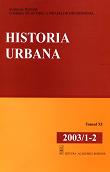Cu privire la patriciatul şi „săracii” din oraşul medieval din Ţara Românească (secolele XIV-XVI)
Regarding the Patriciate and “the Poor” in the Medieval Town of Wallachia (XIVth-XVIth Centuries)
Author(s): Laurenţiu RădvanSubject(s): History
Published by: Editura Academiei Române
Keywords: Patriciate; Poor people; Medieval Town; Wallachia; social clases
Summary/Abstract: The present study is on a less approached theme, referring to the components of the society from the cities of the Wallachia (XIVth-XVIth centuries). The urban hierarchy of this space was led by a class limited to a small group of people, that we should call patriciate. The main difficulty of the researcher of the medieval city from Wallachia arises from the identification of the members of the urban patriciate in the conditions in which no generic name to designate this group of townspeople was considered to exist. We have tried that, by going thoroughly into the studies we have at our disposal and within this group we have identified the following classes: judeţi (leaders of the city council elected by townspeople), pârgari (members of the city councils), to which the „good people” (meliores from the Latin sources) are added. The last ones can be identified by occupation, wealth, privileged relations with the prince and to the towns across the mountains, in Transylvania, being opposed to the so-called „bad people”. Also, I have focused on the transformations within this group, on the background of the penetration of an oriental influence in the XVIth century, which determined the gradual decrease of the importance of the western origin elements (mainly Transylvanian Saxons) in parallel to the increase of the Levantine elements influence (Greeks, Jews). Within the urban society „the poor” also called siromahi had a particular place. The study of the cases from the historical sources led us to the conclusion that the siromahii represented the general mass of the people that consisted of the people belonging to the inferior class of the society. Within this class there entered people with different occupations and orientations, that is why the content of the notion by means of which they are defined should not be generalized; each case is individually analyzed, put in a context and solely in such a manner placed in one environment or another (rural or urban). Likewise, among „the poor” there certainly was a stratification of wealth.
Journal: Historia Urbana
- Issue Year: XI/2003
- Issue No: 1+2
- Page Range: 49-71
- Page Count: 23
- Language: Romanian
- Content File-PDF

